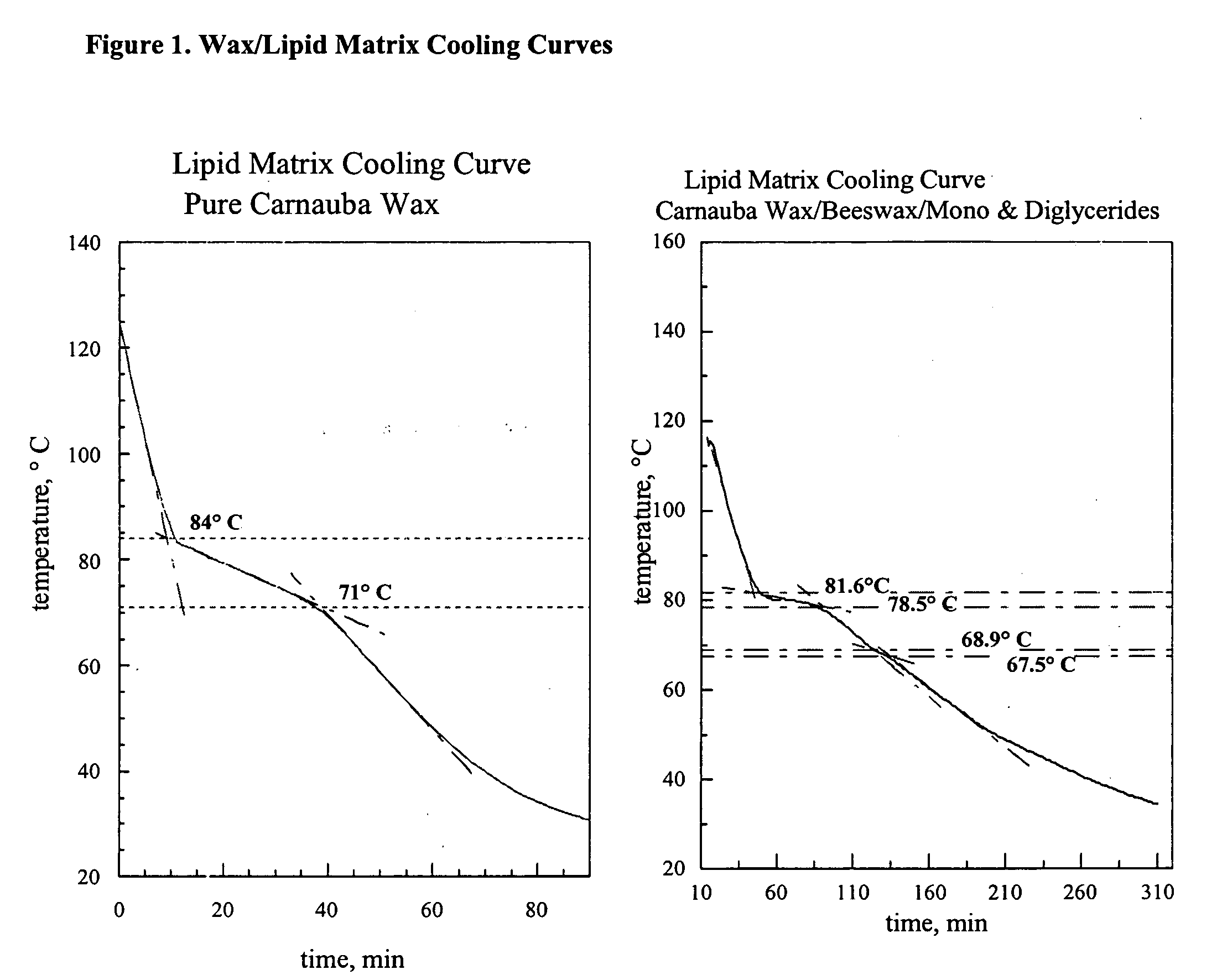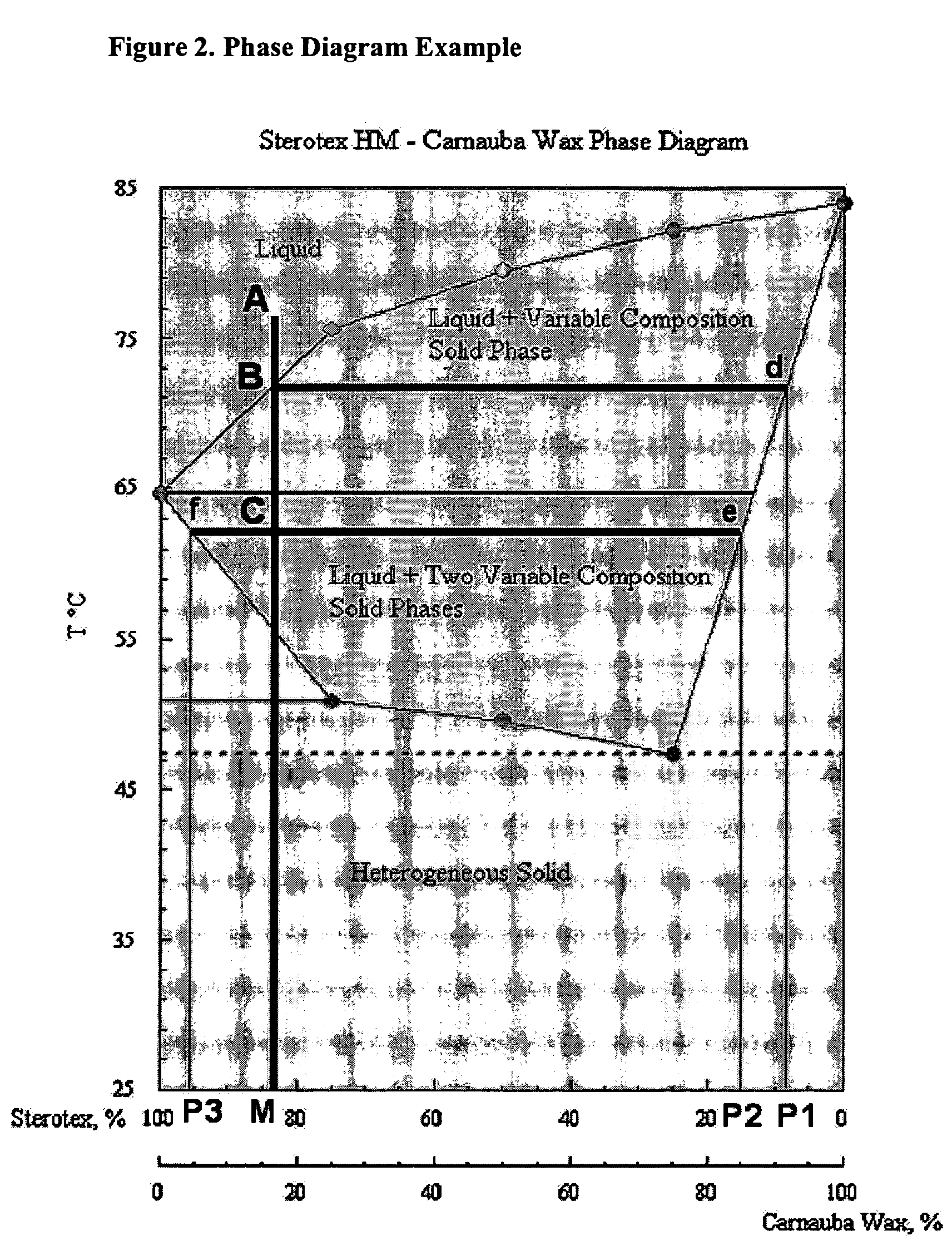Controlled phase composition technology as an improved process for protection of drugs
a phase composition and controlled technology, applied in the field of new drugs, can solve the problems of undesirable immediate increases in drug dose, ineffective masking of drug taste, and particularly acute problems, and achieve the effect of masking the taste of drugs
- Summary
- Abstract
- Description
- Claims
- Application Information
AI Technical Summary
Benefits of technology
Problems solved by technology
Method used
Image
Examples
example 1
Construction of Cooling Curve and Phase Diagram
[0069] A sample of wax / lipid matrix material was melted and placed in a glass test tube. A thermocouple was inserted in the tube. The thermocouple was connected to a temperature datalogger. The material was allowed to cool. The temperature of the sample was recorded at 1 second intervals. The plot of the sample temperature vs. time represents a cooling curve from which transition temperatures can be derived. Representative cooling curves that can be used to construct phase diagrams are shown in FIG. 1.
example 2
Formulation of a Taste Masked Oral Dose Form of Dextromethorphan
[0070] To identify a suitable lipid to wax mixture to produce a suitable controlled phase composition middle layer for the preferred taste-masked but relatively rapidly releasing Dextromethorphan oral dose form, cooling diagrams for seven distinct Candelilla Wax / Mono-& Diglycerides based matrix mixtures were first obtained. This data was in turn used to generate the Phase Diagram shown in FIG. 3. Examination of this diagram demonstrated that the Candelilla Wax / Mono- & Diglycerides matrix containing 17.5% Mono- & Diglycerides formed a eutectic and is predicted to yield a middle layer with favorable taste masking and release properties. In order to produce the taste-masked relatively rapidly releasing Dextromethorphan product, the API was coated with Candelilla Wax / Mono- & Diglycerides based matrix containing 17.5% Mono- & Diglycerides (eutectic). The matrix develops a moderate degree of heterogeneity upon cooling. The C...
example 3
Selection of Lipid and Wax Mixtures with Predicted Migration Control and Release Rate Properties
[0071] In certain instances, it may be preferable to produce oral dose forms with middle layers that promote slower release of the API. The Carnauba Wax / Mono- & Diglycerides based matrix is characterized by the Phase diagram showing a solid solution at less than 5% of Mono-& Diglycerides content (FIG. 4).
[0072] In order to produce the taste-masked relatively slow-releasing Dextromethorphan product, the API was coated with Carnauba Wax / Mono- & Diglycerides based matrix containing 5.0% Mono- & Diglycerides (solid solution). The matrix develops a low degree of heterogeneity upon cooling. The Carnauba Wax / Mono- & Diglycerides coated API is then coated with an acrylic polymer. The product (Lot PDCE-41) was tested for dissolution kinetics (FIG. 5). Release kinetics of the API (Dextromethorphan HBr) from the sample with Carnauba Wax, PDCE-41, is slower than the release kinetics of the API from...
PUM
| Property | Measurement | Unit |
|---|---|---|
| pH | aaaaa | aaaaa |
| pH | aaaaa | aaaaa |
| pharmaceutical composition | aaaaa | aaaaa |
Abstract
Description
Claims
Application Information
 Login to View More
Login to View More - R&D
- Intellectual Property
- Life Sciences
- Materials
- Tech Scout
- Unparalleled Data Quality
- Higher Quality Content
- 60% Fewer Hallucinations
Browse by: Latest US Patents, China's latest patents, Technical Efficacy Thesaurus, Application Domain, Technology Topic, Popular Technical Reports.
© 2025 PatSnap. All rights reserved.Legal|Privacy policy|Modern Slavery Act Transparency Statement|Sitemap|About US| Contact US: help@patsnap.com



